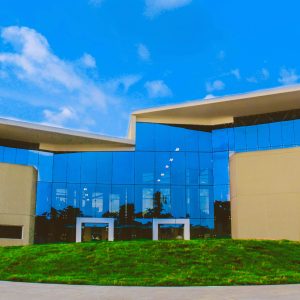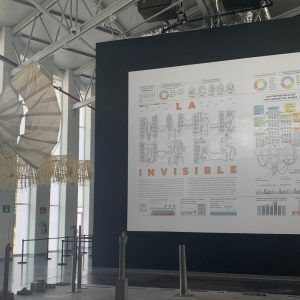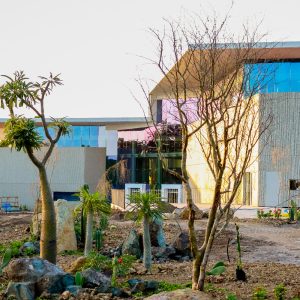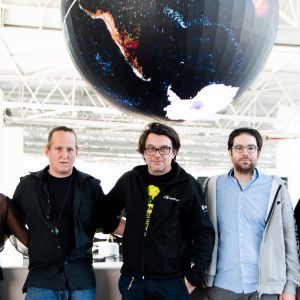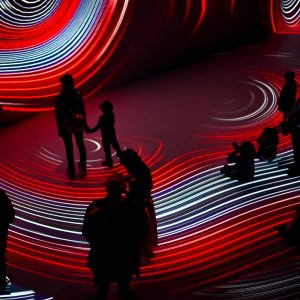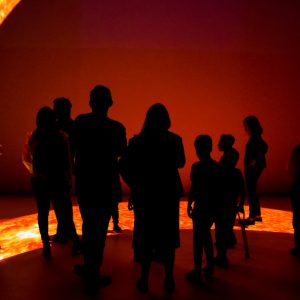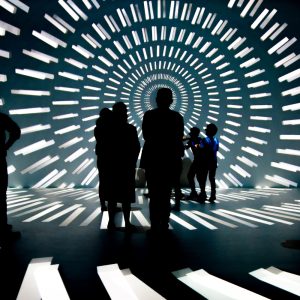The Cave has given way to Deep Space and from there is the Deep Space 8K and nearly the same one exists now in the Sinaloa Science Center (Centro de Ciencias de Sinaloa, CCS), Mexico. What makes Deep Space so unique, what Mexican walls are all about and how a project like this is being realized, is why we’ve got a part of the Ars Electronica Solutions project team together to get answers. We’re talking to Project Manager Michaela Fragner, Senior Director Michael Mondria, Media Technician Patrick Müller, Concept Developer Chris Bruckmayr and Mediation Expert Thomas Viehböck.
The Deep Space 8K in the Ars Electronica Center is a visually very impressive space that amazes people of all ages. Where did it come from and what’s the idea behind it?
Michael Mondria: The thread goes back to the 90s and begins with “Cave”, a 3D multimedia room that played with visual and acoustic boundaries. The Cave was born out of the idea of a virtual reality, which was populated in the 90s, but then vanished again because it was technologically not feasible. Ars Electronica has been implementing the Cave since 1996 and has done great projects there – great in terms of business as well as artistically.

In the new building [of the Ars Electronica Center] in 2009, there was the possibility for a Cave 2.0 and we called it Deep Space. It was conceived as a platform right from the start, not only in terms of formats but also in terms of content. This was a very decisive opening of the environment not only to artists, but also to business and other organizations whose content can be communicated in a unique and immersive way in Deep Space.
In the meantime, VR and 3D have arrived in society and Deep Space has been established in a wide variety of projects. This gives us the opportunity to replicate Deep Space with its idea and potential.
Chris Bruckmayr: There have been smaller replicas such as 2015 in Singapore, but for the first time we have now replicated Deep Space 8K in a large scale at the Sinaloa Science Center in Culiacan, Mexico – where it is called “Cubo Negro” [Black Cube]. Furthermore, we advise the Cultural Capital Timisoara regarding a multiplexity center for Art, Technology and Experiment, because they also want an immersive space. The advantage of Deep Space, besides the community experience, is that it is completely open to the public – anyone can go there. It is a presentation platform that is socially fair and completely barrier-free, also or especially in terms of thinking. In many conversations around the globe we notice that exactly this empathic view is becoming more and more relevant.
The Sinaloa Science Center has been completely rebuilt and reopened in 2020. Ars Electronica Solutions was responsible for the “Cubo Negro”. What is special about the project?
Michael Mondria: Deep Space is not a purely technical project, you have to understand the idea behind it and be able to live it. It is a platform that is open to many formats and people, but this can only be done through – human – mediation, so that the magic of the place comes across. Our Mexican project partners had completely internalized this vision, they understood what they could do with a Deep Space.
Thomas Viehböck: Anyone who has ever visited the “Deep Space 8K” in Linz knows that not only the content, but above all the presentation and interactive elements contribute to the special experience. The Mexican Infotrainer colleagues were eagerly on hand during the several days of training and were looking forward to sharing these incomparable experiences with the Mexican audience.
Michaela Fragner: The entire concept of the Sinaloa Science Center is designed to be temporary, meaning that all exhibitions change after six months at the latest. The only permanent elements are a meteorite and the “Cubo Negro” in the centre of the building – this is not intended to be a mere technological bon mot but a social meeting space. These two permanent installations also served as inspiration for the Science Center logo. This consists of a connection between the Cubo Negro and the meteorite.
In the first month after the opening, the number of visitors skyrocketed – they had as many as they had in a whole year before! There are about 18 shows a day in Deep Space – that’s very ambitious. And they still have potential if they use the location for events and artistic shows.
Which content is shown?
Thomas Viehböck: The content for the “Cubo Negro” comes from the same pool of artists whose works can also be seen in Deep Space 8K at the Ars Electronica Center. Since the technical equipment of the “Cubo Negro” is quite similar to that of Deep Space, all of the selected content could be installed in Mexico without any problems, and any future developments will also take place there. Of course, special license agreements had to be negotiated-most of the artists we contacted find it exciting that their works can now be admired on the other side of the globe.
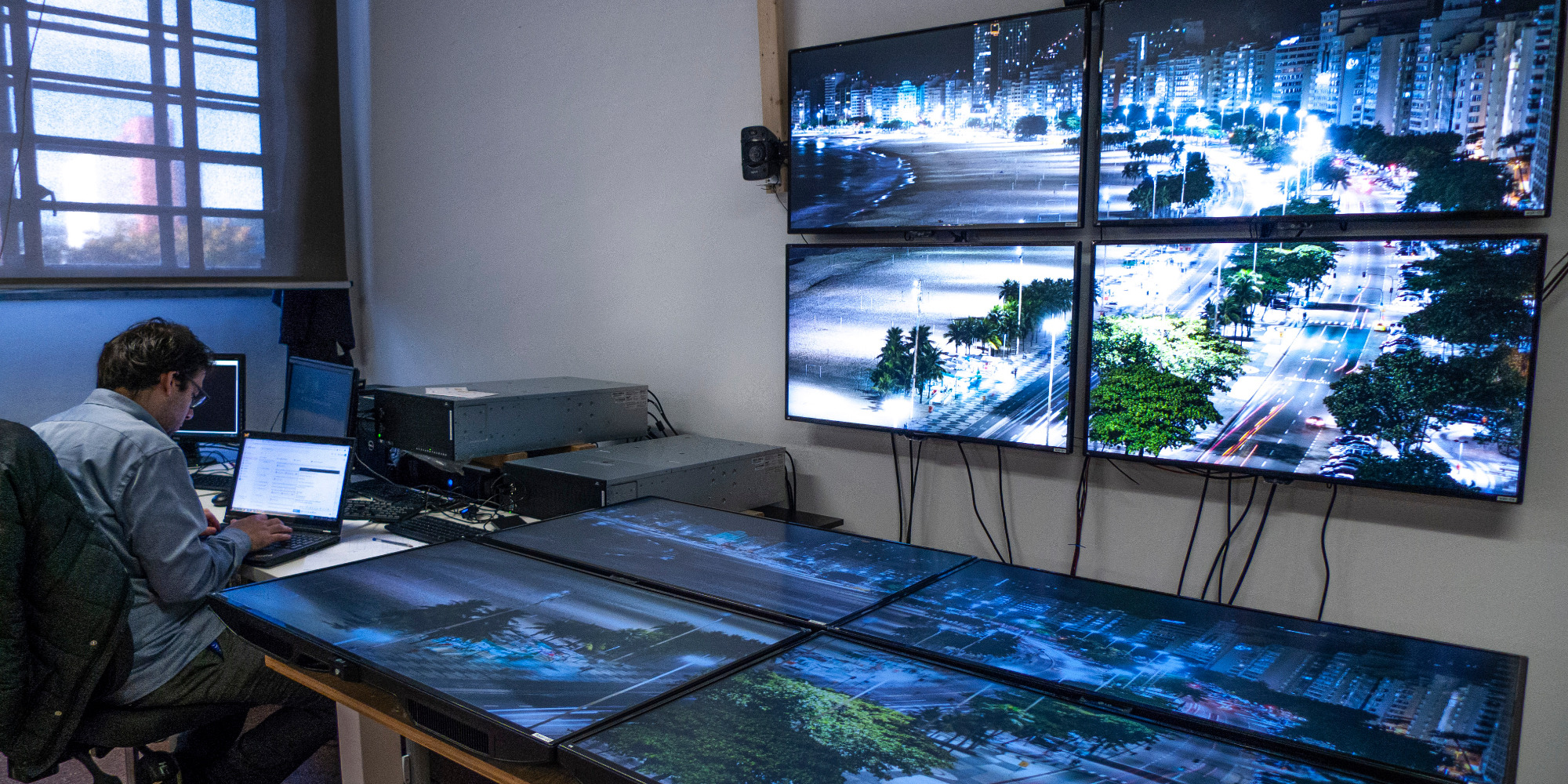
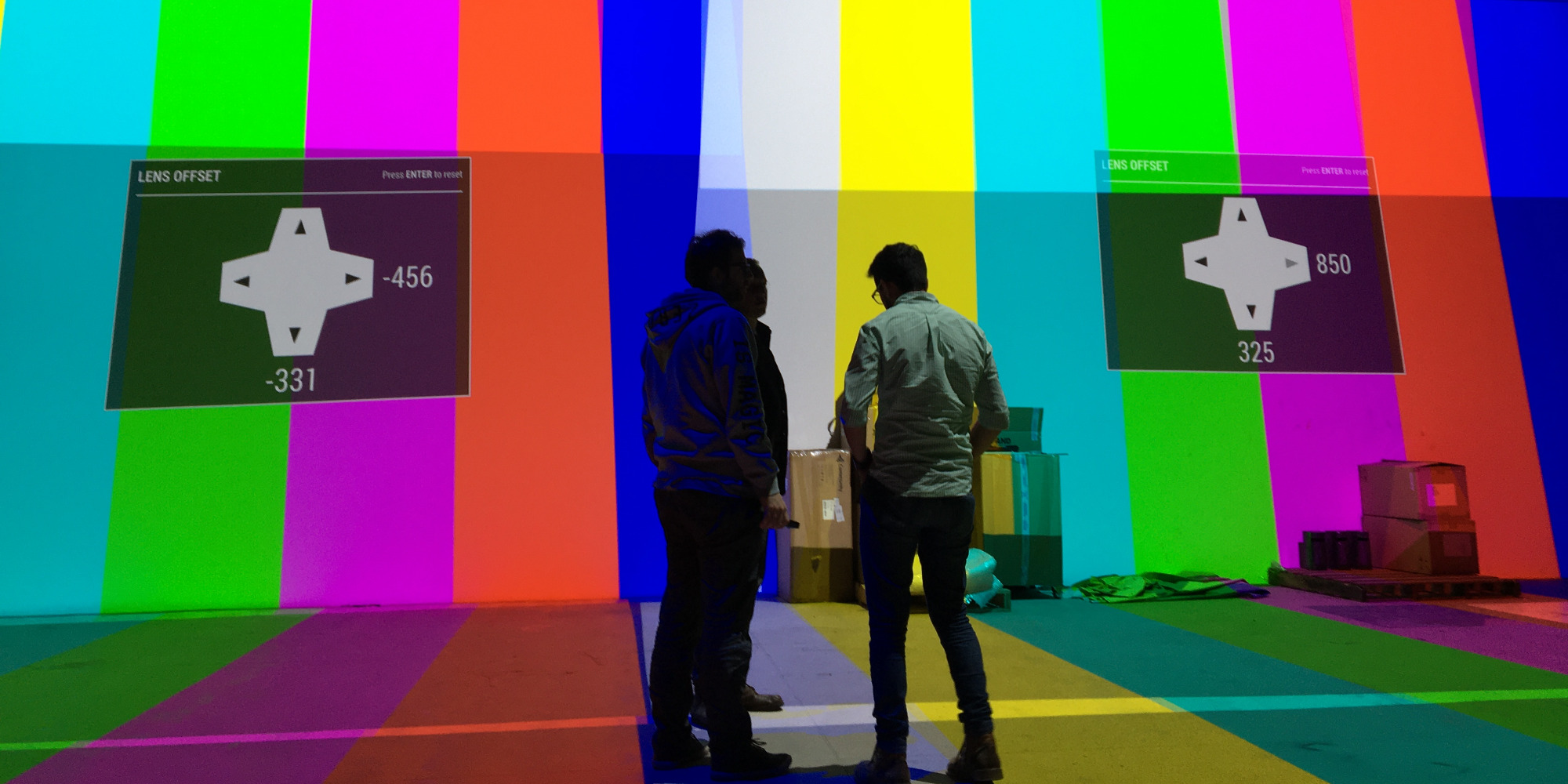
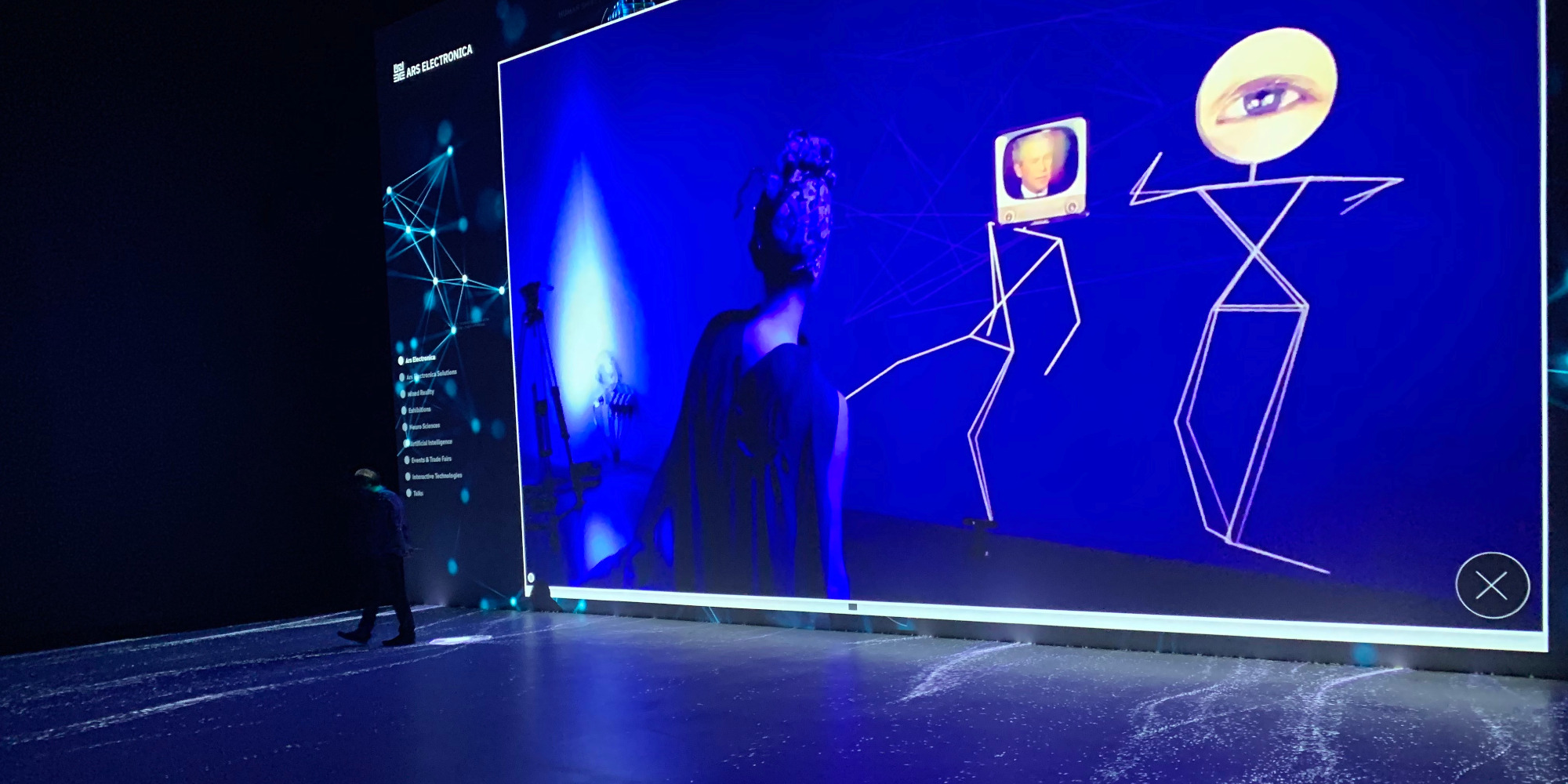

How can we imagine the project handling? What are you doing in Linz, what are you doing on site in Culiacan? How does such cooperation with Mexico work?
Patrick Müller: Ars Electronica Solutions is located in the Tabakfabrik Linz and has several studios for test setups there. In this case we didn’t have eight projectors in original resolution, but we constructed a test setup with eight screens to be able to run through everything effectively. Without a test environment, such a project is impossible.
For the rollout in Mexico, we were able to quickly find a local cooperation partner through our partner company Christie Digital Systems, who took over the implementation there according to our specifications. This enabled us to carry out good planning. However, as the rollout progressed, there were a few “traps”. Complications can arise with very special products that are not on international product lists. And so the computers unfortunately got stuck at customs due to many small factors and we were not able to continue working at the construction site.
Michaela Fragner: As a result, organizational adjustments had to be made again and again, as the technicians and programmers could not work without the hardware. I then took over communication with the customs authorities on site together with the Science Center to speed up the process – we submitted various documents, recorded cable routes, etc. We weren’t alone with the problem anyway, other parts of the exhibition that we had nothing to do with were also stuck in customs. In the end, however, all postponements, adjustments and updates could be bundled at one time and the opening was successfully completed.
Michael Mondria: Everything is a little different in Mexico. In our country, when you say you’re making a wall, you assume the wall is straight. (laughs)
Of course, there are differences in communication and the process, but you simply have to get into it and there are many advantages in bringing Ars Electronica to Mexico. Just to see the joy of all those involved at the opening alone was incredible. Since then, Deep Space has been running very stable and flawlessly.
Patrick Müller: The extensive planning effort in advance and the insistence on hardware, with which we had good experience, really paid off. Especially with a project that is so far away from our base, such an approach is immensely important because you can’t just send someone over to fix minor bugs or set up new projectors. One must not forget how complex the technology behind Deep Space is, even if it seems quite simple for visitors.
What is special for you about Deep Space?
Michaela Fragner: The motivation of the employees in Culiacan was really great and is unbroken. They are researching possible new content and exchanging ideas – for example, they want to present a gigapixel picture of Frida Kahlo. The more motivated people there are here, the better the network that emerges from it and thus, in turn, more and more people inspire each other.
Chris Bruckmayr: The “Cubo Negro”, unlike a normal 3D cinema, has a soul. The mere presence of the employees and the group feeling breathe life into the room. This is different in Mexico than in Linz, but that’s also the great thing about the Deep Space platform: it’s open for everything! It does not fail because of cultural boundaries.
Michael Mondria: Through this openness there is something for everyone that touches you. Be it the dimension of the universe, the view of the earth… it is above all emotionally comprehensible and that is the beauty of the Deep Space.


Michael Mondria is Senior Director of Ars Electronica Solutions. He studied computer science at the Johannes Kepler University in Linz and founded the software company Memetics GmbH in Berlin. Michael Mondria spent 15 years as a software engineer at the multinational software company Fabasoft AG before moving to the Ars Electronica Futurelab as Managing Director. Since 2012 he has been Senior Director of the Ars Electronica Solutions Division.
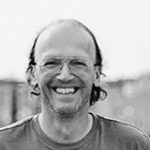
Chris Bruckmayr, Mag., studied communication science, politics and history at the University of Vienna. Academically certified market and opinion researcher. Since 2010 employee of Ars Electronica Linz GmbH & Co KG. 2013-2017: Business Manager and Creative Producer of Ars Electronica SPAXELS® (Ars Electronica’s light drone swarm). Since 2018 Director Products at Ars Electronica Solutions. Sound and performance artist, produces electronic music under the name raum.null for the vinyl-only label Belgrade dubs / Belgrade. 2015-2018: various performances at the Ars Electronica Festival.
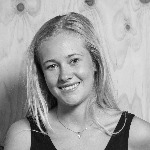
Michaela Fragner has been Project Manager at Ars Electronica Solutions since 2018. Her experience abroad has enabled her to look after many international clients/projects. Her passion for new media is particularly evident in the mediation of innovative installations in concept presentations. In her private life, she is very interested in the subject of psychology, which is why she likes to incorporate aspects of it into visions, concepts and customer consulting.
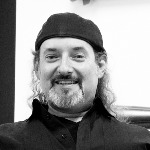
Thomas Viehböck is an artist and project manager at Ars Electronica Solutions. Born in 1975 in Linz, he went into business for himself after graduating from high school at the Kollegium Petrinum and opened the “Starmill Studio” at the Sternmühle in Marchtrenk with a friend. Parallel to his activities as a musician and music producer, he expanded his knowledge and experience in the field of sound and computer technology, including a completed apprenticeship in IT technology and the position of system administrator at the Internet café “Café Online” in Wels. From 2011, he worked as an infotrainer and area manager for the RoboLab and the VRLab at the Ars Electronica Center, before moving to Ars Electronica Solutions in 2019, where he has been a project manager since then.
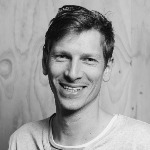
Patrick Müller is an event technician and specializes in projection and display technologies. He has been working for more than 10 years in the fields of technical planning, project coordination and as construction manager for various national and international events and projects such as Prolight and Sound Shanghai 2004, World Expo Zaragoza 2008, various digital signage installations in Austria, projection setup Klangwolke 2012 in Linz.
He has been working with Ars Electronica since 2005.

